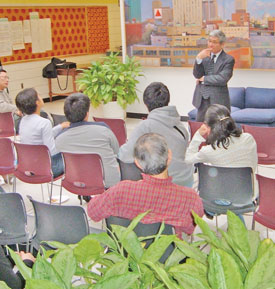Who do you trust to tell the truth? Whose information can you really count on? It’s probably safe to say that the government shouldn’t be counted on without a degree of scrutiny. According to one survey, 83 percent of people believe in a museum. That is, many people think that what they see in a museum is truth, and thus, what a museum presents has a huge influence on their understanding of nature, culture and history. On March 8, Franklin Odo, Director of Smithsonian Asian Pacific American (APA) Program, visited UMass Boston to speak about his work and to have a dialogue with audience about this very topic.
Now, you have probably visited a museum and seen a history of the United States-what kinds of references do you remember to American Indians, Latino Americans, African Americans, and Asian Americans? We surely see a great deal of information about wars between the United States and other countries and their people. For instance, we see what happened during the Vietnam War; what the Unites States did, and what happened to the people in Vietnam. But, do we see what happened to Vietnamese people in the United States during that time or what has happened to Vietnamese people in this country since then? In U.S. history do we really see how much they have contributed to society as Americans?
“Who is going to present and teach a history is important,” says Odo. Majoring in Asian Studies during college in the late 1960s, he felt that what he and his peers learned didn’t fit to what they knew, and realized that the views of certain people had been neglected in educational presentation. In the early 1970s, he became part of the movement that created Asian American and other ethnic studies in California, and he has also made efforts to establish Asian American Studies on the east coast. His concern for the lack of historical materials about the Asian experiences in America increased during his college days, and since then he has collected and introduced histories from the view of Asian Americans through his published books and his teaching at universities. In 2002, he published his latest book, The Columbia Documentary History of the Asian American Experience.
As director of the Smithsonian APA Program, Odo has tried to exhibit parts U.S. history that are enriched by Asian Americans. In 2003, he worked for the exhibition Through My Father’s Eyes presenting post-World War II photographs, capturing the life of a Filipino American community in San Francisco. In 2006, he plans to have an exhibition of Vietnamese American communities, not only focusing on the war (which has been the case for long time) but also talking about the people and their lives in the United States.
At a museum, we don’t expect to read a bunch of words to learn a history but look to objects, such as pictures. In this way, “to present a view of Vietnamese Americans is difficult,” says Odo. “They couldn’t bring art crafts, books, and toys they had used.” One of a few things they still have is an X-ray photo, which was required for immigrants when they tried to enter the country. Odo mentions the idea of using the X-ray photos, but he calls for any suggestion that may work for the exhibition.
Focusing on the point of views of Vietnamese Americans, however, the exhibition will leave out views of non-Vietnamese Americans. When asked how to avoid showing a one-sided view, Odo says what he wants to do is to “provide gates for different views as possible. I think an important thing is to provide the idea of ‘there is no one perspective’.” He also states that even if an exhibition shows a view from one side, it can and has to open up space for the audience to talk and evoke alternative views, and that means being fair to everyone.
“[The] Smithsonian Institute is a national icon,” says Odo. ” [An] icon of how the U.S. presents its-self.” Views of Asian Americans have been invisible in museums, and when they are referenced, it has always been within the context of a war. What Franklin Odo desires is to introduce different views of Americans-all those who have helped to build this country.





















































